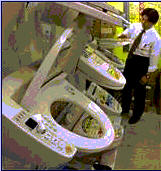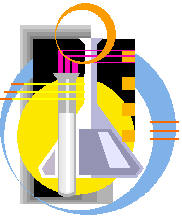| Oldest Extracted Human DNA In Jan 2000 scientists
extracted DNA from the bone of a 60,000 -year-old ancestor of modern humans.
the skeleton, nicknamed 'Mungo Man' was unearthed at Lake Mungo, Australia,
inn 1974. This controversially challenges the theory that we are all
descended from a common African ancestor.
Most Powerful X-Ray Generator

The Z Machine at the Sandia National Laboratories, New Mexico, USA,
can, very briefly, give out x-rays with a power output roughly equivalent to
80 times that of all the world's electrical generators.
Most Cloned Pigs Born In One Litter
The most cloned piglets born in one litter is five. PPL Therapeutics
Plc created the first piglets born as a result of nuclear transfer, named
Millie, Christa, Alexis, Carrel and Dotcom who were born on 5 Mar 2000 in
Blacksburg, Virginia, USA.
PPL Therapeutics' successful cloning of pigs opened the door to making
modified pigs whose organs and cells can be successfully transplanted into
humans. Xenotransplantation, or the transplanting of cells, tissues, and
whole organs from one species to another, is believed by scientists to be
the only short-term solution to solving the worldwide organ shortage crisis.
Most Bitter Substance
Denatonium benzoate is the world's most bitter-tasting substance. It can
be detected in dilution levels as low as one part in 500 million - a
dilution of one part in 100 million will leave a lingering tastes. Higher
levels are too bitter to be tolerated. It is used in products like
antifreeze to deter people from drinking them.
Largest Cloned Animal

On January 6, 2000, Xiangzhong Yang, at the University of
Connecticut, USA, and scientists from the Kagoshima Prefectural Cattle
Breeding Development Institute, Japan, announced the successful cloning of
six calves from skin cells from a bull's ear.
|
Oldest Living Bacteria Uncontaminated bacteria
trapped in suspended animation inside salt crystals for 250 million years [
older than the dinosaurs] have been revived and cultured be US scientist.
Designated 'Bacillus 2-9-3,' this species is 10 times older than the
previous oldest revived bacteria.
Least Dense Solid
The solid substance with the lowest density is aerogel, in which tiny
spheres of bonded silicon and oxygen atoms are joined into long strands
separated by pockets of air. The latest and lightest versions of this
substance weigh just 3mg/cm3, and are produced by the Jet Propulsion
Laboratory in Pasadena, California, USA.
Hottest Flames
The hottest flames is produced by carbon subnitude [C4N2]
which, at one atmosphere pressure, can generate a flame calculated to reach
9,010 degrees Fahrenheit. The highest man made temperature is 100,000 hotter
than this.
Highest Man-Made Temperature
The highest man-made temperature was 520 million K. It was achieved
by the JT-60 (JAERI Tokamak-60) reactor at the Naka Fusion Research
Establishment, Nakamachi, Ibaraki prefecture, Japan, on 19 July 1996.
Lowest Man-Made Temperature
A team at the University of Colorado, led by Eric Cornell and Carl
Wieman, created the coldest manmade temperature in July 1995. In a
university laboratory they cooled atoms of rubidium to a temperature of less
than 170 billionths of a degree above absolute zero - the coldest
temperature possible.
Sweetest Substance
Thaumatin [or 'Talin'], obtained from arils [appendages found in seeds]
of the katemfe plant [Thaumatococcus danielli] from Africa is 615,000 times
sweeter than sugar. It leaves a licorice like aftertaste.
Most Common Element
Hydrogen is the most common element in both the Universe and the
Solar System. Over 90% of the Universe is comprised of hydrogen. Iron is the
most common element on Earth, accounting for 36% of its mass.
Most Sophisticated Toilet
The Washlet Zoe is the most sophisticated toilet in the world.
Produced by Toto, the Washlet first went on sale in Japan in May, 1997. This
remote-controlled restroom revolution has a record-breaking seven flash
functions. They include an automatic, self-lifting lid and a built-in flush
simulator that creates a sound effect to cover embarrassing noises. The seat
is heated and the unit automatically freshens the air after use. There is no
need for paper - the toilet washes and dries the user every time!

|
Hardest Element

Diamond, an allotrope of carbon (C), has a value of 10 on Mohs' scale of
hardness. Diamonds have principally been mined in India, Brazil, South
Africa, and Russia.
Largest Scientific Instrument
The world's largest scientific instrument (and arguably the world's
largest machine) is the Large Electron Positron Collider. It is a circular
tube 3.8 m (12 ft 6 in) in diameter and 27 km (17 miles) in circumference.
It is situated in a giant donut-shaped tunnel 100 m (330 ft) below the area
around the Swiss-French border in Geneva. The machine began operating in
1989 and was officially closed down at 8 am on November 2, 2000. It was used
to examine the smallest particles of matter by accelerating electrons and
positrons that collided with each other. The collisions produced tiny
sub-atomic particles and enabled physicists to study the fundamental nature
of the universe.
Smelliest Molecule

Ethyl mercaptan (C2H5SH) and butyl seleno-mercaptan (C4H9SeH) could
claim to be the worst of the 17,000 smells classified to date. The former is
man-made, and the latter is found in skunk spray. Both contain sulfur, the
source of their pungent odor. Ethyl mercaptan is toxic, and in sufficient
doses will cause headaches, nausea, lack of coordination, and liver and
kidney damage.
Largest Blood Bank
The American Red Cross is the world's largest provider of blood,
plasma, and tissue products. It supplies almost half the nation's blood by
working with more than 4.5 million donors and 3,000 hospitals in a national
network of 38 blood regions. The charity established its first blood center
in New York's Presbyterian Hospital in 1941.
Most Powerful Nerve Gas
VX – more correctly known by its scientific name Ethyl
S-2-diisopropylaminoethylmethyl phosphonothiolate – was developed at the
Chemical Defence Experimental Establishment, Porton Down, Wiltshire, UK, in
1952, and is 300 times more powerful than the phosgene (COCl2) used in World
War I. A lethal dosage is 10 mg-minute/m³ airborne, or 0.3 mg orally.
VX gas is a deadly substance of terrifying potency. Typically it's green and
can smell of rotting fish. Once exposed to air, it vaporizes immediately and
is absorbed by living things. The first symptoms on exposure to the
substance are the loss of muscle control, shortly followed by convulsions
and death.
|
Rarest Element On Earth
The element astatine is the rarest element in the Earth's crust, with
around 25 g (0.9 oz) in total occurring naturally. Astatine is a member of
the halogen group of elements, which also includes, chlorine, fluorine, and
iodine. The element was discovered in 1931.
Finest Balance
The Sartorius Microbalance Model 4108, manufactured in Göttingen,
Germany, can weigh objects of up to 0.5 g. (0.018 oz.) to an accuracy of
0.01micrograms (1 x 10-8 g./3.5 x 10-10 oz.).
Most Accurate Value Of Pi
The most decimal places to which pi (p) has been calculated is
206,158,430,000. Professor Yasumasa Kanada of the University of Tokyo and Dr
Daisuke Takahashi made the calculation by running two different programs in
1999.
Smelliest Substance
The smelliest substances on Earth are the manmade "Who-Me?" and "US
Government Standard Bathroom Malodor", which have five and eight chemical
ingredients respectively.
“Bathroom Malodor” was developed by chemists in America as a way of testing
the effectiveness of deodorants and air fresheners. It emits an incredibly
unpleasant odor that resembles human feces. “It’s very pungent,” explains
Paul Dalton of the Model Chemical Senses Center in Philadelphia. “It fills
your head and gets to you in ways that are unimaginable.”
”Who Me?” on the other hand has a different but equally overwhelming stench.
The sulphur-based substance smells of rotting food and carcasses. It was
originally developed during the Second World War when it was hoped French
resistance fighters would be able to humiliate and embarrass German soldiers
by making them smell horrific. The idea came to nothing since it was
impossible to properly target the smell – instead, it ended up polluting
large areas.
The US Government has now resumed a program to look at possible military
applications of these substances. It’s hoped they could be modified and used
as giant stink bombs to disperse rioting crowds or to keep warring factions
apart
Most Prolific Mathematician
The prolific output of Swiss mathematician Leonhard Euler (1707-83)
was such that his papers were still being published for the first time more
than 50 years after his death. His collected works will eventually occupy
over 75 large quarto volumes.
|


